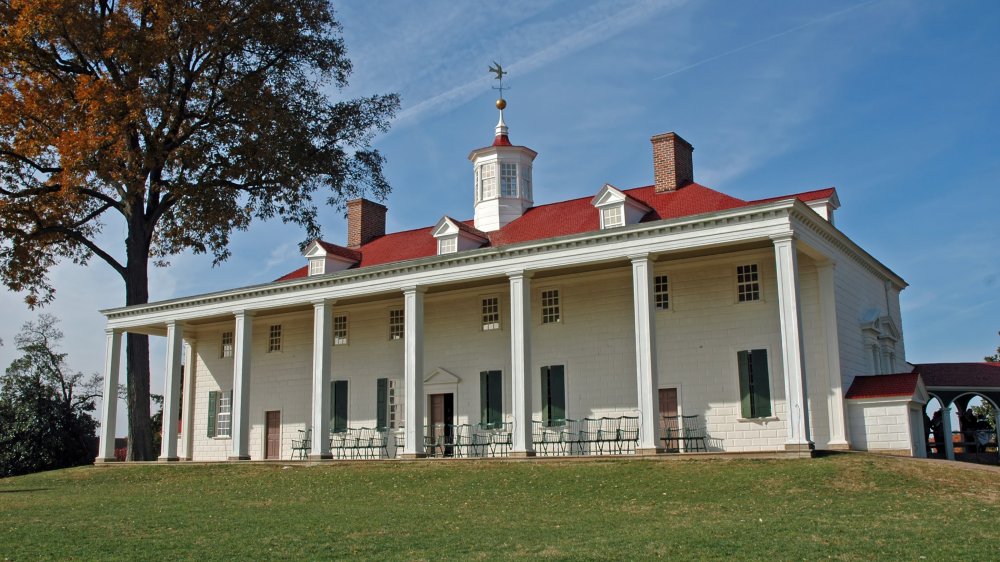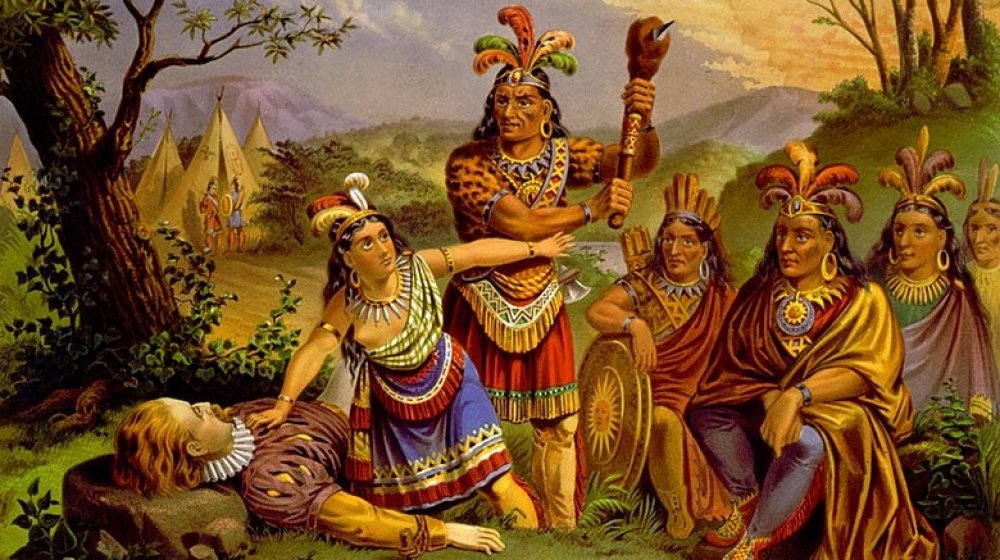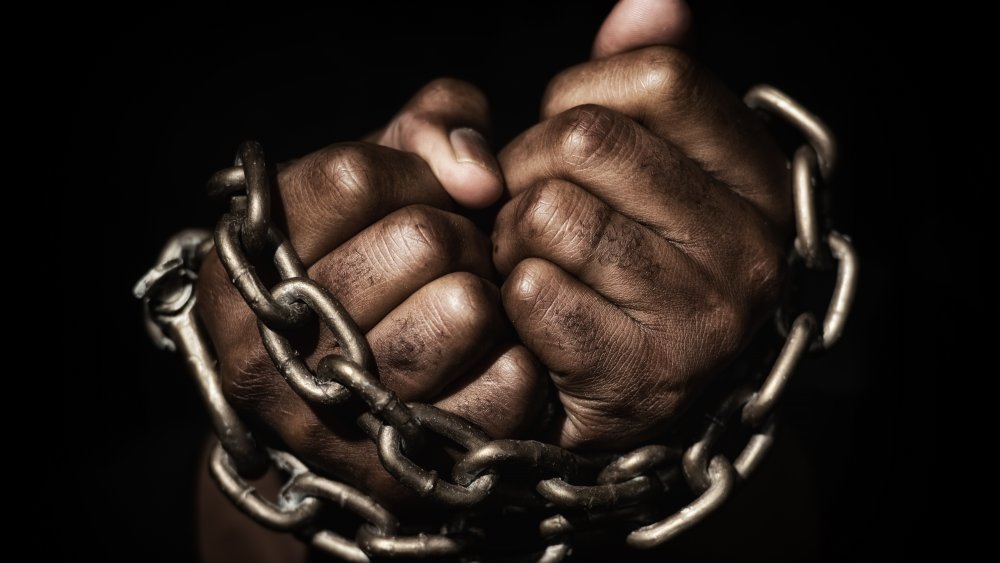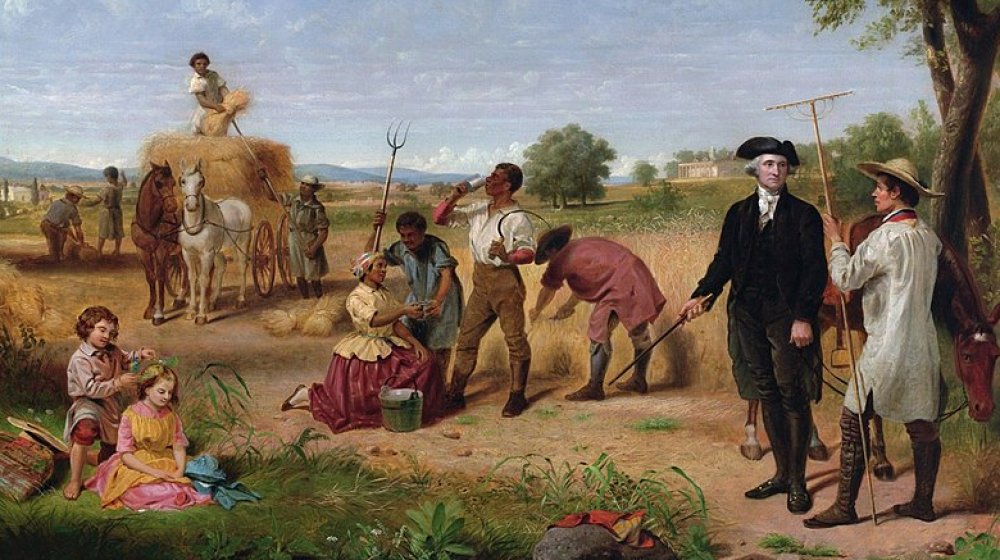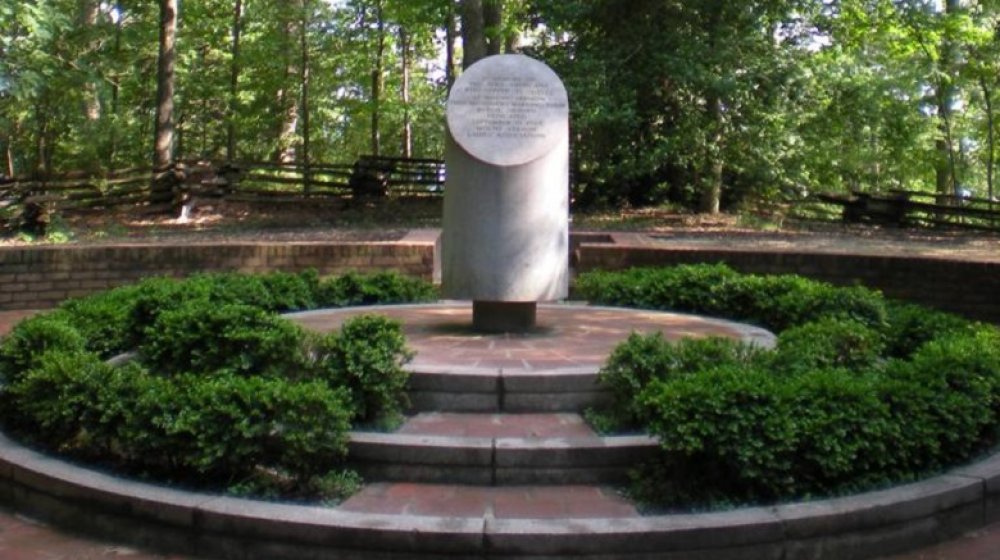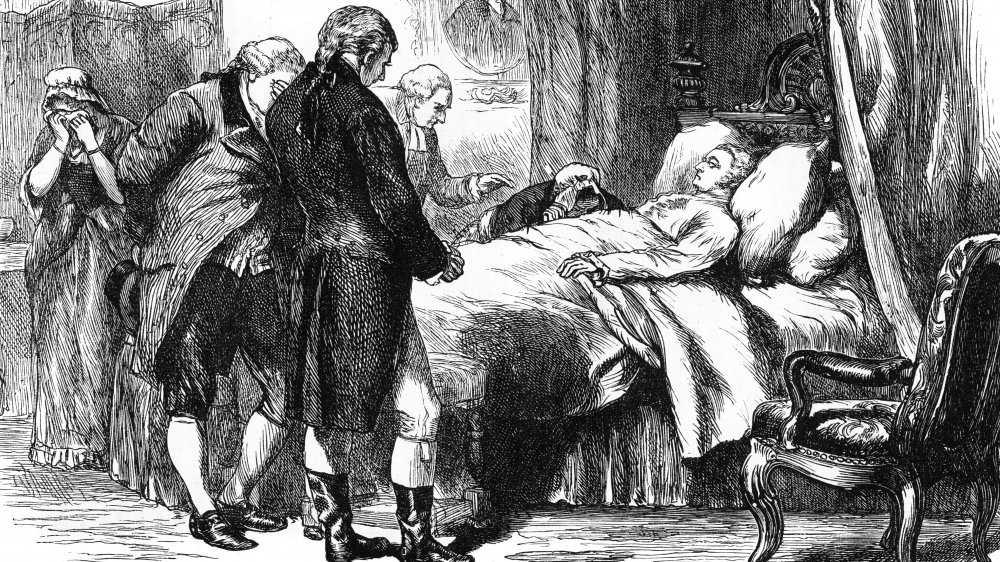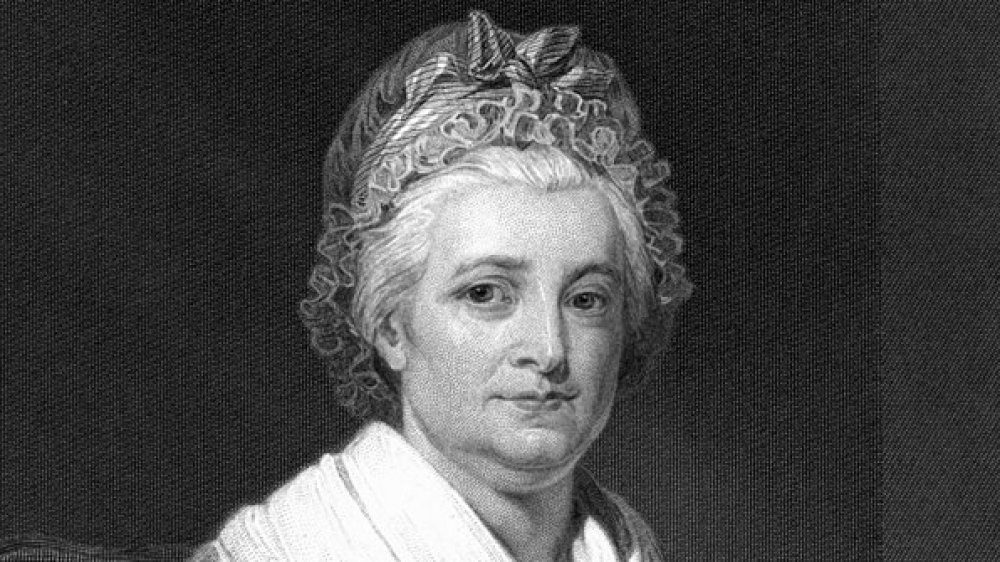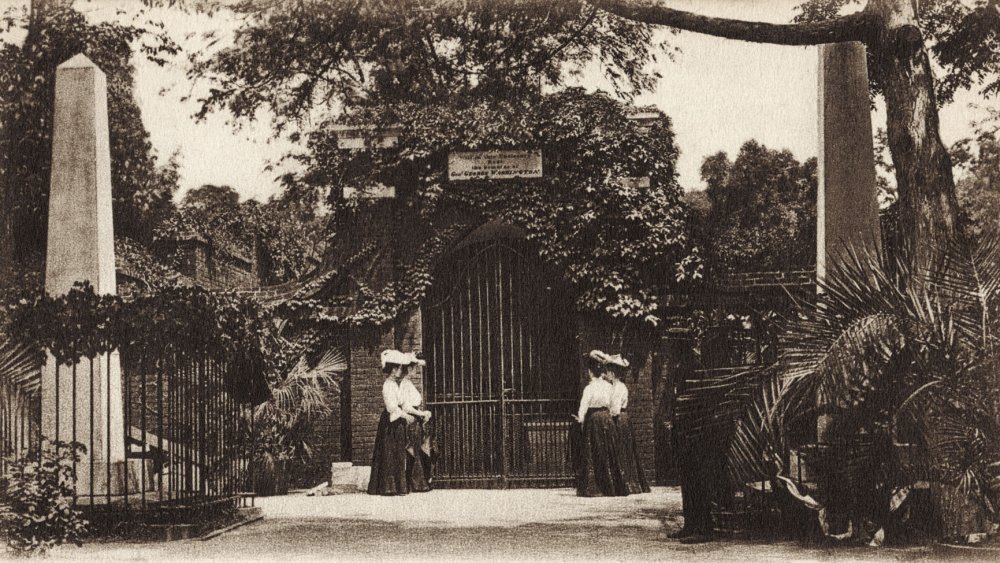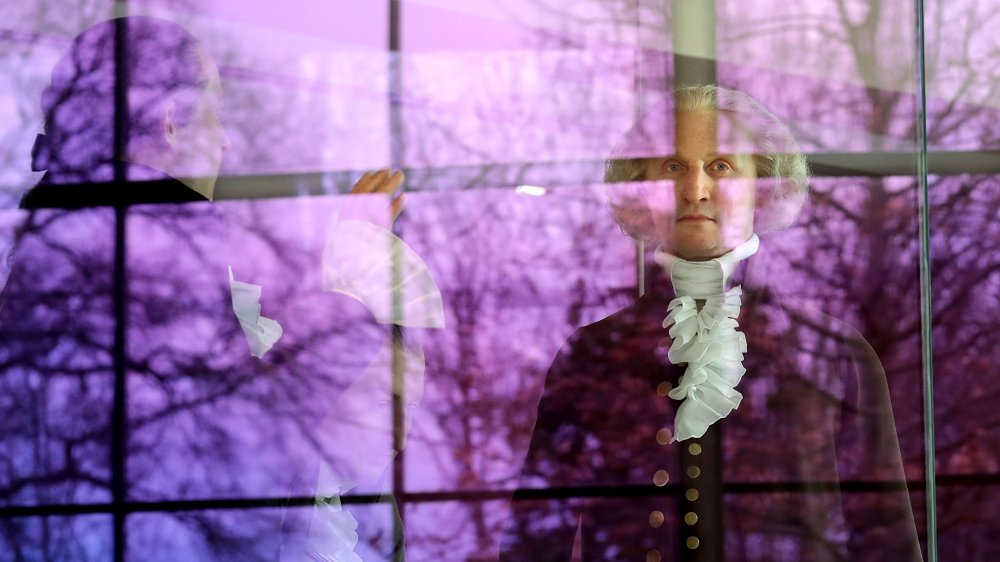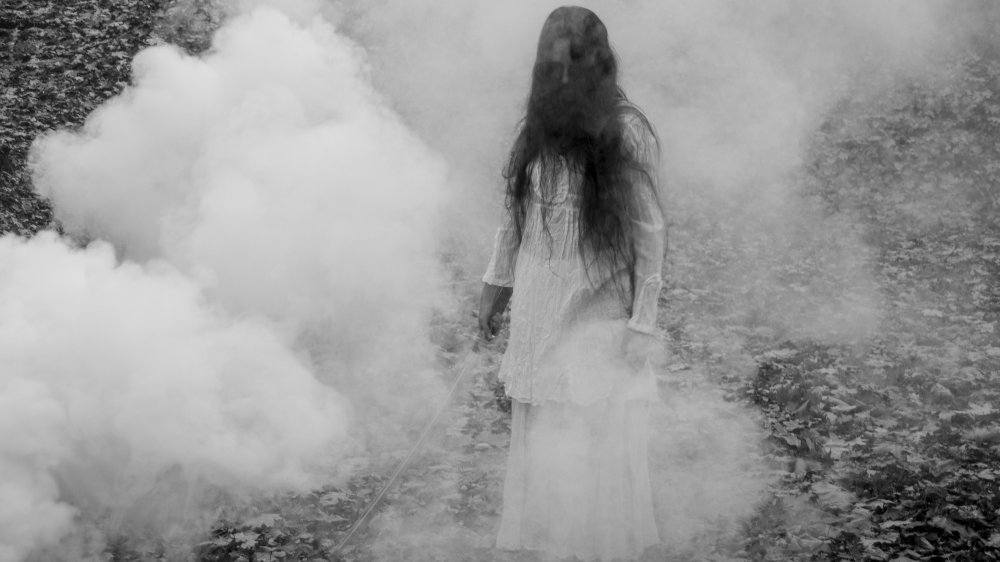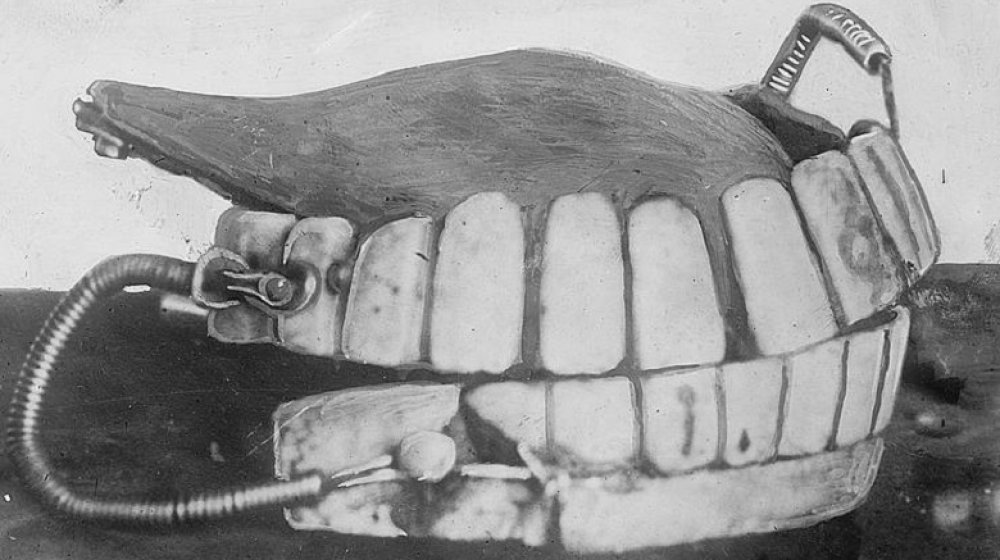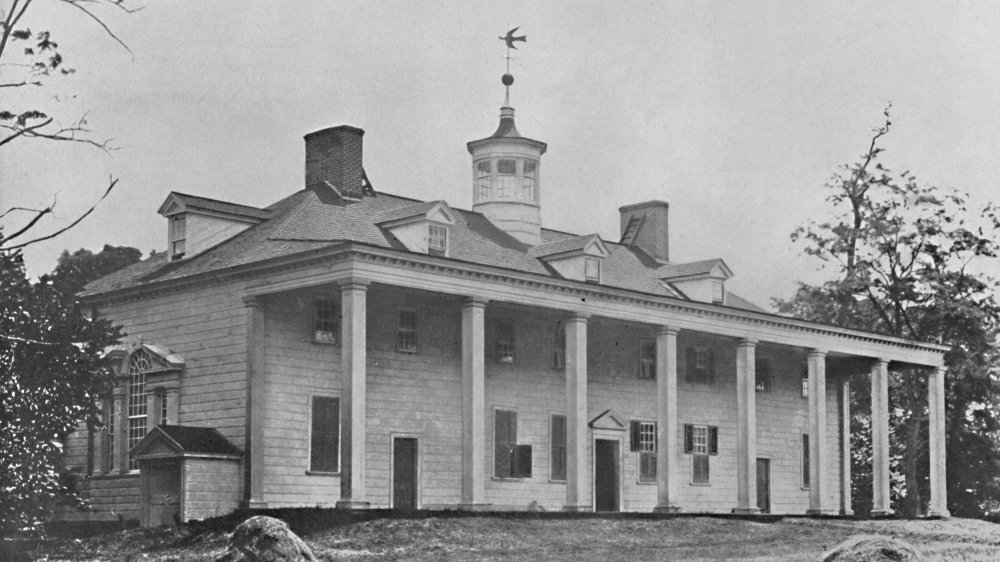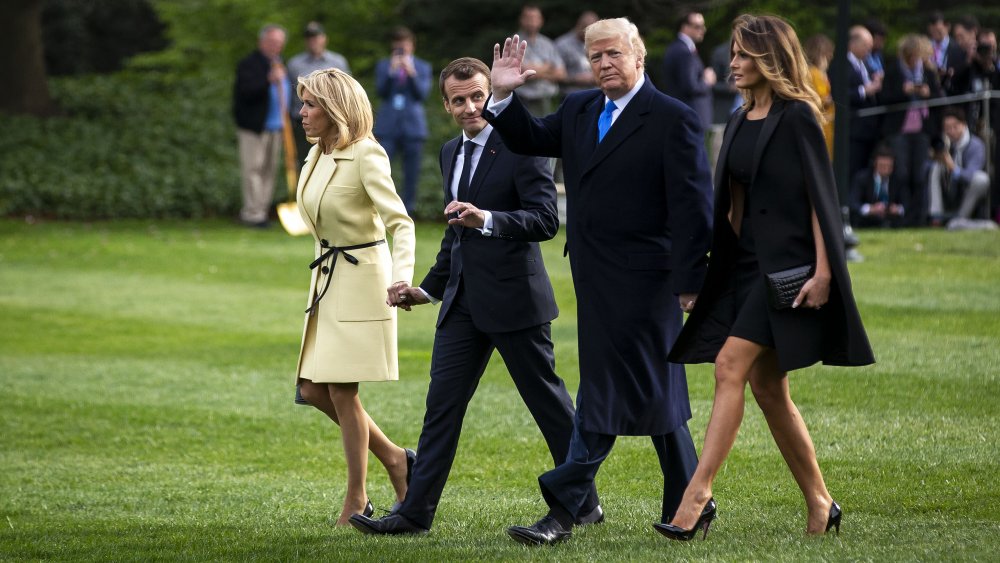The Twisted History Of Washington's Mount Vernon
The quaint and very historic city of Mount Vernon, Virginia is special in many ways — namely because it is home to first president George Washington's ancestral estate of the same name. The gorgeous grounds overlooking the Potomac River include Washington's home, but also numerous other buildings of interest — like Washington's 16-sided, specially designed barn, for instance. Also on the estate is Washington's burial site, an elaborate tomb where the bodies of he, his wife Martha, and other family members rest today. Were it not preserved in 1858, Mt. Vernon might no longer be standing, but the home and its property are now listed on the National Register of Historic Places.
Today, visitors to Mt. Vernon are treated to lots of interesting trivia about Washington's home. A replica of a special weathervane commissioned by the President himself can be seen on the home's cupola (the original was removed to protect it from the elements). Guests can see the restored, furnished rooms of the mansion and much more. And although there are few secrets and no hidden rooms at Mt. Vernon, the place does have some ghostly history, a few interesting facts (like the time Washington had a camel brought in to entertain guests), and some wild artifacts that contribute to its history. Here is the twisted history of Washington's Mount Vernon.
Mount Vernon sits on Indigenous lands
The Mount Vernon Ladies' Association book, An Illustrated Handbook of Mount Vernon, recounts that Washington's grandfather John was first granted the property back in 1674 by colonial governor Lord Culpeper and called it Little Hunting Creek Plantation. At the time, says the Mount Vernon Gazette, some 15 Indigenous tribes were living in Virginia. By the late 1700s, however, many of them were forced to give up their lands to the United States government, according to Virginia. Not until President George H.W. Bush's designation of National American Indian Heritage Month in 1990 did states begin looking harder at America's Indigenous history.
Beginning in 2016, State Delegate Paul Krizek recognized 11 of Virginia's tribes of people (including Pocahontas, pictured) and how important they were to the state's history. "Too often, Virginia's American Indian tribes receive little acknowledgment for the hardships they faced or the contributions they made," said Krizek.
In 2019, the Washington Post had reported on high school students Dominic Anderson and Jared Phillips who discovered a 6,000-year-old Native American ax at Mount Vernon during an archaeological dig. "Artifacts such as this," commented archaeological curator Sean Devlin, "are a vital resource for helping us learn about the diverse communities who shaped this landscape throughout its long history."
Washington's enslaved workers at Mount Vernon
Mt. Vernon spanned an amazing 8,000 acres when Washington inherited the property in 1761, says History. Four expansive gardens, five farms, and the mansion were maintained by over 300 enslaved workers. One man who toured Mt. Vernon noted that guides today refer to these people as "enslaved" rather than "slaves," because they were forced into their lot in life. True to slave ownership of the time, "field slaves" received only two sets of clothing and one pair of shoes per year. Those who worked within the home wore better clothes, but all were forced to live in simple barracks or one-room cabins with no insulation and only a blanket to stay warm.
George Washington could be a cruel enslaver. Mount Vernon confirms that he approved of whipping when "warranted," or even selling his enslaved workers if they attempted to escape. Punishments were meted out to those who broke too many tools, worked too slowly, or stole food. Roughly 47 slaves made escape attempts, sometimes en masse. Although none of the original slave quarters stand today, some of the buildings have been reconstructed and a memorial stands in the forest where many enslaved people are buried. Notably, the spirit of Washington's personal servant, William Lee, has allegedly been seen moving among the trees by visitors.
Washington later felt guilty for owning slaves
It is true that George Washington was raised to believe slavery was acceptable and owned ten enslaved workers by age 11, according to the Daily Beast. Without their forced labor, as an adult, he may not have become one of the wealthiest presidents of all time. Washington recognized marriages between his enslaved workers and prevented separating couples when he could, says Pilot Online. He also gave them holiday time off. However, there is overwhelming evidence that Washington did separate his enslaved workers from their families and whipped them during punishments, according to History. Washington eventually did grow uncomfortable with the idea of owning other human beings over the years — but did not free any of his slaves during his lifetime, fearing Mt. Vernon's profits would be risked.
Still, Mount Vernon says, Washington did come to realize that harsh punishment versus encouraging words could backfire. And his conscience ate at him to the extent that he freed those he enslaved in his will. Martha Washington, however, didn't get that memo and refused to free any of them but William Lee — that is until she believed the rest were trying to kill her. Even so, Martha Washington willed her own enslaved workers to her children from her first marriage. Washington's descendants continued to keep enslaved workers at Mount Vernon until after the Civil War.
Mount Vernon's monument to enslaved people
In 1983, the official "Slave Memorial" was installed in the cemetery once used for Mount Vernon's enslaved people. There, according to World Strides, some 50 to 100 of Washington's enslaved people are buried. Nobody seems sure of the number due to the number of unmarked graves, but elsewhere on the grounds are at least six buildings dedicated to the hundreds of enslaved laborers who toiled at Mount Vernon, according to History. Notably, there is a wreath-laying presentation almost daily. But while Mount Vernon does provide special tours and information about enslaved individuals on its website, are these people well represented?
Margaret Zeddies at The Sociologist doesn't think so. Zeddies took the regular tour at Mt. Vernon in 2019 and found that "pockets of information where slavery is discussed are fragmented," including discussion of enslaved people owned by Washington. Worse yet, actor Reginald Richard, who portrayed slave Frank Lee in 2019, was horrified when a white woman grabbed his arm in front of school children and announced, "I got one, I got one of the slaves." Pulling Richard to a group of students, the woman commanded the actor to speak in a "slave voice," telling him, "Oh I'm talking like Aunt Jemima so you'll understand me better." Gads! Richard rightfully told the Washington Post that "it felt like a sucker punch."
Was George Washington cared to death?
In 1796, according to History, George Washington opted out of seeking a third presidential term. He retired to Mount Vernon, keeping up his daily habit of overseeing the vast estate. Doing so on a stormy and very cold day on December 12, 1799, however, proved his undoing. Returning home late, Washington opted to dine in his wet clothes so as not to disappoint his guests. The next day, he again went out in inclement weather. By evening, the former president fell terribly ill. Constitution Center verifies that various doctors were summoned. Per their orders, Washington gargled with molasses, vinegar, and butter (which choked him). He inhaled steaming vinegar. His throat was swabbed with a mixture that included dried beetles. He was given an enema and drank herbal teas.
Nothing helped. Worst of all, the physicians applied "bloodletting," wherein the sick man's blood was drained for a bit of time — until some 40% of it had been taken. Much weakened by the measure, the sickly Washington was fed up by December 14. History Today quotes him as telling the doctors, "You had better not take any more trouble about me, but let me go off quietly. I cannot last long." They didn't listen and continued applying more useless cures until the Father of our Country died later that night. Although scientists have since theorized over what really killed Washington, they have yet to arrive at the true cause of the president's death.
Martha's reaction to the death of Washington
Around 10 on the night of George Washington's death, Martha stood wringing her hands at the end of her husband's bed, according to History Today. Writer Ron Chernow submits that Washington feared being buried alive when he issued a final command before he passed. "I am just going!" Constitution Center quotes him as saying. "Have me decently buried; and do not let my body be put into the vault less than three days after I am dead. Do you understand me? ... Tis well!"
Martha Washington was so bereaved that she did not attend Washington's funeral. And in the days following, according to Washington DC Metro Area, the widow "closed up the marital bedroom." Maybe because she was so sad she couldn't bear to stay in the bedroom, Washington moved her things to a different bedroom on another floor and used it for the rest of her life. Until she died nearly three years later, the bedroom Martha shared with George Washington remained locked away from the rest of the world. But the grieving widow did another strange thing too: she burned nearly every letter Washington wrote to her, says Washington Papers, perhaps hoping to keep her relationship with him private. Today only three letters survive: two which were found in a desk Martha gave to her granddaughter and a third which Martha missed in her husband's personal papers.
Two family tombs lie on the property, but only one is used
Today, George and Martha Washington lie in a family tomb overlooking the Potomac River at Mount Vernon. But that tomb is not the only one on the property, according to Washington DC Metro Area. The couple was originally in an older family mausoleum that included upwards of 25 other family members. The two oldest interments were Washington's nieces, Jane and Sarah, who died in 1745. Other nephews and nieces were also laid to rest there, as well as George's half-brother Lawrence and Martha's daughter from her first marriage, Martha Parke Custis.
Before his death, says History, Washington noted that the old family tomb was deteriorating, enough that he wished to replace it. In his will, he decreed that part of his estate money would be used to build a new tomb where he, and the rest of the family, were to be reinterred. What is officially referred to as the "New Tomb" was completed by 1831 when the family fulfilled Washington's request. Visitors can still see the Old Tomb on the grounds, which is just as dank and uninviting inside as one might guess. The New Tomb, meanwhile, is gated but the doors are open for guests wishing to peer inside.
George Washington haunts the grounds
Not even Mount Vernon can deny that George Washington's ghost continues to wander around his beloved home. In fact, Josiah Quincy III claimed to have seen Washington's spirit as early as 1806 while visiting Mt. Vernon — and while sleeping in the former president's bedroom. During the night, Quincy saw Washington's ghost, and surmised that he was angry because the shroud on his coffin was tattered due to "relic hunters." Try to Scare Me claims the spirit even moves stuff around and speaks to visitors, also that a "dark shadow" can be seen in Washington's bedroom.
It only seems natural that the bedroom is the biggest draw for seeing Washington's ghost. Bustle published a photograph from an Imgur user that includes a shadow with an eerie resemblance to Washington. And ghost hunter Rob Gutro talks on his blog of visiting Mount Vernon and feeling a stabbing pain in his throat in an upstairs bedroom. Minutes later, he said, the docent on duty claimed that Washington also had "a sharp pain in his throat" just before he died. Gutro was standing just outside of Washington's bedroom at the time. Today, Mount Vernon uses some of the ghost stories as a scare tactic to keep visitors from touching artifacts.
The ghost of Washington is not alone at Mount Vernon
George Washington's spirit is not the only one floating around Mount Vernon. In fact, the place is so rife with ghosts that Ghostly Podcast dedicated an episode to the ghost sightings which actually date over one hundred years. One story, which was reported by New York World circa 1890, focuses on Washington's bedroom which still contains the bed he died in. A Mrs. William Beale and her friend were sleeping in it when their candle, situated in the middle of a water basin for safety, began "sputtering." Hmmm. Not such a great story, since water would naturally make a candle sputter if the two came in contact.
It is notable that most of the numerous ghost stories cited on Mount Vernon's website took place much later. They vary from mild — seeing figures drifting through the mansion, alarms going off at odd hours, hearing the sound of keys being carried — to wild. Like the visible ghost of former director Colonel Harrison Howell Dodge who shouted "What the hell is going on here?" at a docent as a school group passed through. Another time, two security officers patrolling at night watched in horror as a small girl on the path ahead of them suddenly appeared right beside their vehicle. A ghost also has been seen hanging around Washington's tomb. And, according to Try To Scare Me, visitors and docents alike have seen people moving around and heard songs being sung around the slave memorial.
The weird artifacts at Mount Vernon
Smithsonian Magazine verifies that although some of the Washingtons' belongings were sold after his wife died, some items such as clothing, furniture, tableware, and personal items, were kept and returned to Mount Vernon over time. These include, oddly enough, a bedpan used by the couple in their early years. More curious is a set of George Washington's dentures. Live Science explains that Washington had terrible teeth, losing them one by one until he wore a set of dentures by 1789. And contrary to folklore, they aren't made of wood. No, the President's chompers are actually made of combined materials that include ivory, metal — and human teeth. They are believed to have been purchased from enslaved people or poor people by Washington's dentist in New York.
There's more: In 1766, Mount Vernon says, Martha ordered material to make a dozen chair cushions and spent 36 years applying her own needlework to them. Six of the cushions, which were purchased in 1960, survive. And, if one man's trash is another man's treasure, Mount Vernon's old trash pit is a veritable gold mine. Mount Vernon Midden lists hundreds of items dug up over time. The artifacts include pieces of pottery and china, but also buttons and beads, buckles, and even a couple of Native American spear points and tools. But the trash pit also dates well beyond the Washington family's time: a 1926 Brownie Scout ring has also been unearthed, as well as a modern "Gumby" doll.
Women, not men, saved Mount Vernon
It's hard to believe, but had it not been literally saved from falling apart, Mount Vernon might not stand today. Here's what happened, according to Forbes: George and Martha Washington had no children, so Martha left the estate to her husband's nephew, Bushrod Washington. Bushrod also died without children and left the estate to a distant relative. Subsequent owners did little for the place, and by the early 1800s, Mount Vernon began suffering serious wear and tear. There was no National Trust or any other preservation organization to buy it and the owner at the time, John Augustine Washington III, put Mt. Vernon up for sale for $200,000. Enter Louisa Bird Cunningham, who was traveling along the Potomac River one evening in 1853 and happened to notice what bad shape Mount Vernon was in. Cunningham wrote a letter about the situation to her daughter, Ann Pamela Cunningham.
Ann Cunningham began writing letters to newspapers asking for help. The letters spread nationwide, spurring a bevy of support for saving the estate. The end result, according to History, was the purchase of Mount Vernon by the Mount Vernon Ladies Association in 1858, making them the first national historic preservation organization in America. The Association still owns Mount Vernon, with 22 board members overseeing its care.
President Trump's visit to Mount Vernon
In April 2018, Patch made a special announcement: President and First Lady Trump were coming to visit Mount Vernon with French President Emmanuel Macron and his wife. The estate would be closed to the public at 1 p.m., and locals could expect higher traffic volumes than usual. True to the announcement, the White House reported that the Trumps and Macrons would be dining at the estate. The White House later announced that the dinner went well, and everyone had a nice time.
Fast forward one year, when the media got hold of the details of Trump's tour. Politico submitted that the President was more interested in whether Washington was "really rich" than the history of Mount Vernon. Even Trump admitted he held little interest in the history of the nation's leaders before him, which Mount Vernon CEO Doug Bradburn said made it difficult to lead a tour interesting enough to keep the President's attention. The Mount Vernon Ladies' Association was quick to respond to the media reporting Trump's "bizarre" visit, stating that the comments made did "not correctly reflect the events that transpired." But even they could not deny the one quote that set reporters laughing as the White House grimaced. "If he was smart, he would've put his name on it," Trump said of Washington's Mount Vernon. "You've got to put your name on stuff or no one remembers you."
